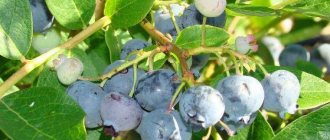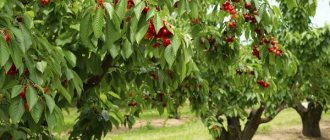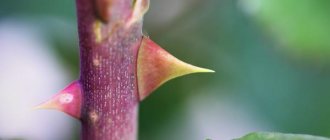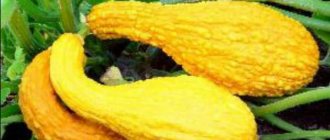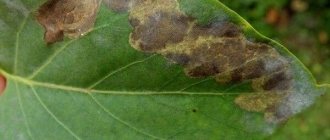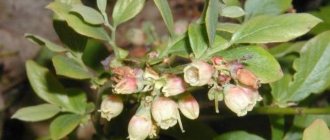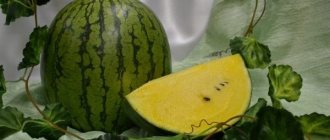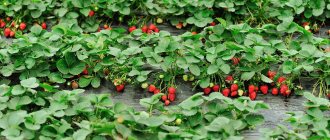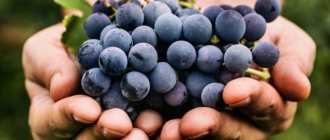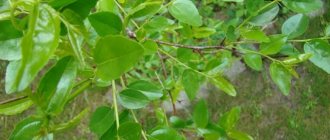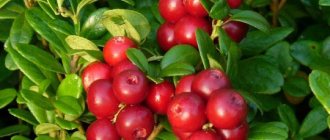Description Chandler
You can admire him, you can dream about him.
You can be disappointed in it - but just don’t remain indifferent at the sight of huge berries, collected almost like bunches of grapes. Launched by Shandler in 1994. Recommended for cultivation in regions with moderately cold or mild snowy winters. Late fruiting - produces berries 10-14 days later than Bluecrop (according to Polish sources).
- Bush height from 150 to 170 cm, with strong, powerful, fast-growing shoots. The habit is elevated, branched.
- The fruits are large – rounded-flattened, blue, with a light, intense waxy coating and a neat scar. The fruits are tender, delicate, and do not transport well over long distances - recommended for the fresh market and fresh consumption.
- The leaf is large, shiny, bright green, pointed (lanceolate).
- The flowers are large, white (white-pink).
- Productivity is high. The training camp lasts from 4 to 6 weeks, from early August to mid-September.
- Frost resistance is moderate - 24...-28 C, winter hardiness is average (USDA zone 4).
Advantages of Chandler or variety for gardeners
It is advertised, praised, called sensational, scolded - but does not remain indifferent - the Chandler blueberry received very contradictory reviews. In terms of fruit size, it is practically the largest-fruited. Sometimes extended fruiting is called a plus, but this is a controversial advantage. On the one hand, harvests stretched until September, and according to some sources - until the middle of September, make Chandler attractive to gardeners and summer residents. On the other hand, in small-scale production for the fresh market and the average, extended harvesting is not profitable, although the high commercial qualities of the berries convince us otherwise. In large industrial areas, both in North America and in Europe, the cultivation of the variety is not practiced due to its whimsical nature and, again, the extended fruiting period: where harvesting equipment is used, long-lasting varieties are not always held in high esteem.
About the cons
- Long ripening period and extended fruiting period;
- It is whimsical in agricultural technology, loves abundant fertilizing - on large areas it requires a large feeding area.
- Long-term storage is inappropriate due to low shelf life and transportability.
In the photo, Chandler blueberries are singing - a variety that is lucky: they are talking about it.
Are its owners lucky? Not the highest winter hardiness: without shelter and protection from the wind, they do not risk growing it over large areas in Europe - in particular, in Poland. And since shelter is a tool mainly for gardeners and small farms, this allows us to draw certain conclusions: Chandler blueberries should be a variety for gardeners and small commercial production.
Cultivation agricultural technology: blueberry basics
Loves light, humus-rich soils with a pH of 3.8-4.8. Seedlings are planted in spring or autumn in pre-prepared planting nests filled with organic substrate up to 1 x 1 in size and up to 50-60 cm deep. The planting distance between plants is up to 2.5 m, between rows 3 m. The feeding area of the bush should be at least 1.5- 2 m.
The seedling is carefully removed from the container, the roots are straightened so that they are not bunched up. If it is impossible to remove, soak it. They are planted in a new place a few centimeters deeper than the seedling grew in the container, watered abundantly, and mulched.
Important: when using powdered sulfur for acidification, prepare the soil in advance, at least 6 months before planting.
Pruning of spreading plants begins at 3-4 years, before that it is only sanitary. First of all, branches with larger branching on the periphery, hanging towards the row spacing, inclined at an angle of more than 45°, and also interfering with the growth and enlargement of powerful and straight skeletal branches are pruned. In the first year, some resourceful gardeners lightly tie the plants, accustoming them to a compressed habit: during this time, the shoots, growing wood, learn not to sag. An adult bush should consist of 5-6 shoots 3-4 years old. For 5-6 years, anti-aging pruning is needed.
Fertilizers are applied in early spring - they provide 50% nitrogen, then the rest is distributed during flowering and ovary. Stop fertilizing with nitrogen until mid-July so that the plants overwinter well. Nitrogen fertilizers are used in sulfate form - ammonium sulfate, superphosphate, etc. In nitrate form - they can harm plants by changing pH.
For the winter, young plants in cold regions should be covered according to the principle of grapes; in regions with mild, snowy winters, the root zone should be covered with snow and covered from the wind with spunbond.
It is easy to conclude that the blueberry variety Chandler is not zoned for most countries of Eastern Europe, including the territory of Belarus, Russia, and Ukraine. According to manufacturers, incl. European, the variety is not suitable for industrial production. Poor winter hardiness, coupled with the need for care, and an extended fruiting period make its cultivation risky and not profitable. This is how the fate of the variety developed, which, according to the idea, was extremely promising: its size is in demand in amateur gardening and small agribusiness. Of course, it is also in demand on the seedling market - but that’s a completely different story. But don’t be sad—perhaps the large berries will please gardeners.
Characteristics and description of Chandler blueberries
The bush bears fruit late, 2 weeks later than the Bluecrop variety. The berries are more suitable for fresh consumption, as they are not shelf-stable. Blueberries leave no one indifferent not only because of the huge berries that ripen at the same time, but also because of a number of features.
Characteristics of blueberries:
- berries are large, flattened, blue with a whitish waxy coating;
- the fruits are delicate and difficult to transport over long distances;
- The harvest is abundant, regular, harvesting lasts from 4 to 6 weeks, from the beginning of August to September 15.
The bushes can withstand frosts up to 28 degrees, winter hardiness is average.
Dimensions and branching of the bush
A tall shrub grows up to 150 cm in height. The plant has strong, fast-growing shoots and a branched habit. The foliage grows large, white and pinkish. When in bloom, the garden takes on a romantic atmosphere. Blueberries serve as an additional decorative element.
Flowering and fruiting
Chandler blueberries begin to bloom from late June to mid-July. Fruiting starts from the beginning of August, lasts 1.5 months, until October 15. During this period, up to 8 kg of berries can be collected from one bush. Thanks to the extended fruiting period, gardeners can collect fruits as they ripen, even on weekends.
This sign will not appeal to farmers whose activities are aimed at simultaneously obtaining a large amount of crops for sale.
Collection and use of berries
Large-fruited blueberries are harvested in 5-6 approaches, since the yield is extended. The collection starts from the bottom of the bush and ends at the top. The berries are widely used for fresh consumption. The blue, tasty and dense fruits are also used to make preserves, jams, candied fruits, and decorate desserts.
Susceptibility to diseases and insects
The Chandler blueberry variety has powerful immunity and resists fungi, aphids, and cancer. Sometimes you have to fight harmful bugs or diseases with the help of chemicals or folk remedies. The protective functions of the plant depend on proper care and soil fertilization. If left unattended, blueberries will often get sick.
Resistance to low temperatures and drought
The Chandler blueberry variety can withstand frosts of -28 degrees. In most regions of Russia and other CIS countries, this temperature is the norm. The variety is recommended for cultivation in the South, since in northern and middle latitudes, the berries require shelter and can freeze.
Collection and storage of blueberries
The harvest begins in the first ten days of August. Chandler is not suitable for industrial cultivation - the berries do not ripen simultaneously, but within 4-6 weeks. This does not allow the use of specialized harvesters. The berries do not tolerate storage and transportation well.
This feature also became the reason for refusing to grow Chandler on an industrial scale. It is better to process fruits immediately after picking. They can be stored in the refrigerator for 7–12 days in glass or wooden containers, in birch bark baskets. If the fruits are dried, their shelf life increases to 9–12 months.
If frozen, they can be stored for up to a year.
Chandler is a high-yielding blueberry variety whose berries have a sweet dessert taste. Despite certain demands on care, it remains popular among amateur gardeners.
Planting a crop on the site
The holes are made in standard sizes - 50*50*60 cm, maintaining a distance between bushes of 2.5-3 meters. One plant should have a space of at least 1.5-2 meters. After planting, constant watering is required, keeping the soil humidity within 70%. Drying out or too much moisture will harm the plant.
To retain moisture, the root circle is covered with a mulch layer. Then frequent watering will not be required.
Optimal timing
Seedlings are planted in open soil in spring or autumn; sprouts can be replanted from March to the end of October, as long as there is no frost, along with the soil. In the South, autumn planting is possible, provided the climate is warm; the young bush will have time to form a rhizome before frost. In the northern regions and the middle zone, planting work is carried out in the spring. It is important that the earth warms up 15-17 cm deep. The air temperature should not fall below 10 degrees Celsius. Otherwise, the seedling will freeze.
Suitable soil
Blueberries prefer to grow on loose soils, with a high content of sand, peat, and acidity within the range of 3.8-4.8 pH. You can plant bushes next to sorrel, mint, and horsetail. If the acidity is 6, blueberries will grow slowly. On neutral or alkaline soils, the variety may not take root.
Germination by seeds
Blueberries are widely propagated using seeds, which are obtained from fully ripened, good fruits. After separating the pulp from the stone, they are dried, and in the fall they are planted on the territory in shallow holes. Before growth, you need to steadily weed, moisten and feed. Afterwards, the young bush is transplanted to a permanent place. It is important to maintain an optimal distance between plants, approximately 0.5 meters.
Growing by cuttings
Propagation of the blueberry variety by root cuttings starts with preparation in November. They are separated from the parent, placed in sand, and placed in a cool place. In 2 years, with careful care, they will turn into viable seedlings. Planting material can be planted in open soil to obtain a harvest for the next year.
Growing
Blueberries of any variety, and Chandler is no exception, prefer loose soils, with a high content of peat and sand, and acidity in the range of 3.8-4.8 units.
Seedlings are planted in a permanent place in spring or autumn; sprouts in containers can be replanted from early spring to late autumn, along with the soil.
The holes are standard sizes 50x50x60 cm, the distance between bushes is 2.5-3 meters. The feeding area of one bush should be at least one and a half to two meters.
After planting, seedlings require constant watering; soil moisture should be between 60-70%. Drying out or excessive moisture will not benefit the plant. To preserve moisture, the root circle is covered with mulch; in this case, there will be no need to water the plant frequently and in large portions.
On average, an adult bush requires 10 liters of water per week, which is applied twice a week. In the hot season, the plant is watered more often; in summer, moisture is needed not only for the current harvest, but also for the formation of flower buds for next year's harvest. Without watering next year, the fruits will be much smaller, even if this year pleases with a high harvest.
Drip irrigation is best suited for blueberries; thanks to the sprayer, moisture penetrates the soil gradually, and at the same time moisturizes the leaves, saving the plant from overheating and drying out.
Fruit bush care
Caring for blueberries is not difficult, you just need to pay a little attention to them. The following manipulations are carried out:
- regular watering, feeding, weeding;
- mulching beds;
- bush pruning;
- preventative treatments against bugs and diseases.
In the North or in mid-latitudes, bushes need to be covered for the winter.
Watering and fertilizing the plant
Blueberries need to be irrigated 1-2 times a week, depending on weather conditions. For 1 bush you will need 10 liters of water, pre-settled. Do not pour cold liquid, it harms the plant. Regular watering ensures a stable harvest and the formation of flower buds for the next year. Without irrigation, there will be fewer berries.
Drip irrigation is widely used, moisture is sprayed into the ground gradually, the leaves are moistened, and the crop is saved from overheating and drying out.
Fertilizers are applied in March - 50% nitrogen substances. During pollen and ovary, the rest is added. Nitrogen fertilizing is completed in mid-July so that the plant can safely overwinter. Nitrates are not used, they harm blueberries and change the acidity of the soil.
Mulching and loosening beds
To mulch blueberries, use hay, peat, sand, sawdust, leaves or straw. These items are used to cover bushes to protect them from temperature changes, beetle attacks and diseases. A layer of mulch makes the soil looser, more fertile, lighter, and retains moisture.
Subtleties of care and ripening time
The Chandler variety is quite demanding in terms of care. Immediately after planting, young plants are shortened by 1/3 or half, creating a balance between the above-ground part and the roots - the crown will not take most of the nutrients, allowing the root system to develop. For the first 2-3 years, pruning is not necessary. Only in the spring do they remove all frozen, dry branches and part of the growth inside the bush - this will ensure good air circulation in the crown.
A properly formed adult bush has 10–15 skeletal branches.
You can also trim the branches of the lower tier if they are heavy and lie on the ground. Formative pruning of adult bushes is carried out in the spring before the buds swell, removing all horizontally growing shoots up to the first strong vertical shoot, second-order branches growing deeper or downward, damaged, dry shoots. Old woody branches are also removed, leaving a few new ones that have grown from the roots.
Blueberries are cut at the root:
- if it is necessary to save a drying plant;
- if she has gone wild and has not been restored to health for a long time (about 5-6 years);
- if after abundant fruiting small fruits are set and there are very few of them.
Chandler is a late-ripening variety. The berries are harvested from early August to mid-September.
Watering
The variety does not tolerate both waterlogging and drought. It is necessary to maintain soil moisture within 60–70%. On average, one young plant needs about 10–12 liters of water per week, and an adult - 22 liters. Usually watering is carried out 2 times a week in the evening.
For Chandler, drip irrigation is especially suitable, when moisture enters the soil gradually. Sprinkling can be used to reduce temperatures and humidify the air.
Top dressing
Chandler requires plenty of feeding. Mineral fertilizers (ammonium sulfate, superphosphate, etc.) are applied in the spring and after fruiting. Good results are obtained by using the Dutch fertilizer " Mivena ". It is applied once, 50 g per bush. " Mivena " not only regulates the acidity of the soil and gradually supplies blueberries with nutrients, but also protects them from fungal diseases.
Reviews about the variety
Below are responses from gardeners who grow Chandler blueberries on their property. They will help you learn about all the nuances of the variety.
- Irina Novoselova, 68 years old, St. Petersburg. Hello! Chandler learned about the blueberry variety from a neighbor. I decided to try the culture in my garden. I planted 8 berry bushes. Fruiting occurred a year later, the berries were large, and the harvest was about 30 kg. I prepared smoothies from them, added them to baked goods, and made jams.
- Alexander Vinnichenko, 59 years old, Kyiv. Greetings! I have been growing blueberries for over 15 years. I recently started growing the Chandler variety. The harvest is always abundant, the fruits are large, juicy, and sweet. The bushes were sick with aphids, I removed them with chemicals. I recommend this variety to everyone to grow!
Blueberry Chandler (Cherndler, Chandler): description of the variety, planting and care, cultivation
Blueberries are native to North America; the main cluster of shrubs is on mountain slopes, floodplains, and in undergrowth. Wild species formed the basis for breeding varieties that differ in bush size, level of fruiting and frost resistance. Chandler blueberries are one of the first cultivars to appear on the Russian market. The variety was created by European breeders in 1994 and adapted to the climatic conditions of the temperate zone.
Description of the variety
The garden blueberry variety Chandler, as in the photo above, is a late-bearing perennial deciduous plant. Belongs to tall varieties, the height of mature blueberries is 1.5-1.7 m. The shrub is spreading, branched, crown diameter is 1.5 m. Chandler blueberries with a high degree of frost resistance, without damage to the stems and root system, withstand temperatures down to -25 0 C.
The Chandler variety is cultivated in regions with cold winters and in the south. Blueberries are especially popular among gardeners in Siberia, the Urals and the middle zone, and are often found in gardens in the Moscow region. Chandler blueberries are grown for gastronomic purposes and as a designer option. The shrub remains decorative for the entire spring-autumn period from flowering to the change in leaf color. At the end of September, the bush turns yellow, then bright burgundy; the leaves do not fall until the first snow.
External characteristics of Chandler blueberries:
- The bush is round in shape, spreading, forms numerous fast-growing light green young shoots. The perennial stems are completely woody, gray with a brown tint.
- The Chandler blueberry bush is densely leafy, the leaves are 3.5-4 cm long, they are located opposite. The shape of the plate is obovate with a sharp apex. The surface is smooth, hard, with a pronounced light central vein. The cuttings are thick and short.
- The flowers are pitcher-shaped, small. The buds are pink, and after blooming they are white, drooping. Flowering is abundant.
- Fruit clusters are formed on last year's shoots, density - from 8 to 12 berries, located on the outer part of the bush.
The root system is superficial, underdeveloped, the roots are thin and fibrous. They cannot provide food for blueberries on their own. The planting microelements of the Chandler variety necessary for the growing season are obtained from interaction with the mycelium of the fungus, the so-called mycorrhiza; the symbiosis provides nutrition for the mushrooms and shrubs.
Features of fruiting
The high yield of the Chandler variety is ensured by late flowering, which occurs in June; frosts at this time are rare even in the Northern regions. The berries ripen unevenly; harvesting continues from August to September. If you do not have time to harvest part of the harvest before the first frost, the blueberries do not fall off and completely retain their taste and shape.
Chandler blueberries form their first single flowers in the 3rd year of growth; they are removed from the bush. The productivity of young blueberries is insignificant; a certain amount of nutrients is required for fruit ripening, which will slow down the growing season. Blueberries produce a full harvest in the 5th year of growth; 5-7 kg of berries are harvested from one bush. The yield of the variety is stable every season, the plant is dioecious with cross-pollination.
Chandler refers to large-fruited blueberries:
- berries weighing – 2-2.5 g, diameter – 3 mm;
- round shape, slightly compressed on both sides;
- The fruits acquire a dark blue color at the stage of technical ripeness, the color does not change until full ripening;
- the surface is smooth with a thin bluish film of waxy coating; on the upper part there is a receptacle with jagged edges;
- The pulp is dense, light purple with small brown seeds.
The taste is sweet and sour, the composition is dominated by sugar. Blueberries of this variety are juicy and have a delicate aroma. The fruits are consumed fresh, made into wine, processed into jam, and frozen. Shelf life is within 3 days. The peel is thin and poorly resistant to mechanical damage, so transportation is difficult. Chandler is one of the few blueberry varieties that is not grown commercially. The fruits are picked by hand; the berries are not picked dry.
Advantages and disadvantages
Referring to reviews from gardeners about the variety, Chandler blueberries cannot be characterized unambiguously. The culture has its advantages over other varieties, but it also has disadvantages.
Features of reproduction
Chandler blueberries are propagated only vegetatively:
- By layering. Before the buds swell, the lower branch is dug in drops and watered constantly throughout the season. Next spring, cut out areas with rooted buds and plant them.
- Dividing the bush. Blueberries that are 4 years old are suitable for this method. Work is carried out before flowering.
- By cuttings. The material is taken from the middle part of last year's shoots in mid-June. Place it in the ground at an angle, water it, and cover it for the winter. In the spring, young shoots will appear on viable seedlings; strong material is selected and planted in the designated area.
Chandler blueberries take root well; any chosen method of propagation will give a positive result.
Planting and care
Before planting, a self-grown blueberry seedling is disinfected with a manganese solution (the root is left in for 4 hours) or with an antifungal drug, and act according to the instructions. Then they are placed in Kornevin, a growth stimulator, for 3 hours. No preparatory measures are needed for the purchased material; the seedling is processed before sale. The main requirement for blueberries from the nursery:
- seedling not younger than 2 years old;
- without fungal and mechanical damage;
- with closed root.
Recommended timing
Blueberries of the Chandler variety take root quickly, and the frost resistance of adult shrubs and seedlings is at the same level. Blueberries are planted in spring and autumn. The timing is based on the weather conditions of the region. In spring, planting is possible after the soil has warmed up to +8 0 C. For the central part of Russia - in May, in the south - in March-April. In autumn, planting is carried out 40 days before frost.
Site selection and soil preparation
The fruiting rate and growth rate of Chandler blueberries is entirely dependent on sunlight. The variety does not tolerate even partial shading. The place should be open, with satisfactory air circulation, the plant is not afraid of drafts.
Soils need to be light, aerated, well-moistened, and always acidic. You can plant blueberries in lowlands or wetlands. Over-wetting of the roots is normal for the variety; drying out leads to the death of the mushrooms, and subsequently the blueberries themselves. Before planting, the area is dug up. And to increase the acid level, colloidal sulfur is added.
Landing algorithm
Pre-prepare nutritious soil, mix peat with sawdust and a turf layer of soil. A hole with a diameter of 55*55 cm and a depth of 60 cm is dug the day before planting and completely filled with water. The acquired seedling has fungal spores embedded in its root system. If the material is grown independently, the mycelium is pre-harvested; it can be purchased at a nursery or specialized retail outlet.
- The bottom of the planting hole is covered with ½ part of the nutrient substrate.
- Mushroom spores are sprinkled on top.
- Blueberries are placed vertically, the root system should completely cover the area with the mycelium.
- Fill with the rest of the mixture and compact.
- The recess is filled to the edge with soil, the root collar is left on the surface.
- Fill with plenty of water and mulch with peat and sawdust or pine needles.
For mass planting, the distance between bushes is 1.5 m.
Landing rules
It is preferable to choose 1–3 year old seedlings with closed roots as planting material. Blueberries should be planted in October - November or April - May, choosing well-lit places protected from drafts and winds. If the planting date is missed, work can be carried out in the summer, but only in cloudy weather. Spring planting is preferable, since in the fall the plant may not have time to take root well and become stronger.
For spring planting, holes (trenches) are prepared in the fall, for autumn planting - 2-3 weeks before the event. During this time, the introduced soil will settle and compact. Chandler is particularly picky about soil composition. On alkaline soils, blueberries bear fruit worse, their taste deteriorates, and the plants get sick more often. It is advisable to prepare a special, rather acidic soil, with a pH of 2.8–3.5, which will contain at least 30% of acidic high red peat.
The rest of the soil mixture may consist of sand, rotted pine sawdust, pine bark, etc. Although, according to some gardeners, sawdust slows down the growth of bushes. They should be added to holes prepared in the fall for planting in the spring. During this time they will have time to rot. Therefore, when planting in holes, they dig a hole 50–80 cm deep and 60 cm in diameter, leaving 1.2–1.5 m between bushes and 2.5 m between rows. A thick layer of nutrient soil is poured into the bottom of each hole.
The root system of blueberries is superficial, located at a depth of 40–60 cm.
The trench planting method is more labor-intensive and is suitable for industrial cultivation of blueberries, since the consumption of peat substrate increases significantly. As a rule, using technology, they dig a trench 35–40 cm deep and 50 cm wide. As with the pit method, nutrient soil is poured to the bottom. The bushes are planted, maintaining a distance between plants of 1–1.5 m.
The seedlings are carefully removed from the shipping containers, the roots are straightened, placed in holes or trenches, and covered with nutrient soil. After planting, the ground around the bushes is watered abundantly and mulched with a mixture of sawdust, bark and forest soil with a layer of 10–15 cm. In addition to retaining moisture and controlling weeds, such mulch will constantly and gradually acidify the soil.
Growing and care
Agricultural technology for Chandler blueberries consists of frequent watering, fertilizing, and pruning. It is also important to maintain the required soil acidity.
Watering schedule
The daily norm of moisture consumption for blueberries up to 3 years of growth is 5 liters, an adult bush needs 8 liters. This norm is used to determine the amount and frequency of watering. The procedure is carried out in the morning or evening. In hot months with low air humidity, in order to prevent the bush from overheating, blueberries need sprinkling in the morning. The main task in care is that the tree trunk circle should not be dry.
Feeding schedule
Fertilize the Chandler variety the next year after planting. In the spring, nitrogen-based products are applied; at the time of fruit set, a mixture of superphosphate (115 g), potassium sulfate (40 g) and ammonium sulfate (95 g) is prepared. The norm for 3-year-old seedlings is 2 tbsp. l., for an adult bush - 5 tbsp. l.
A prerequisite for normal growth and fruiting of blueberries is maintaining the required soil acidity. In a neutral environment, the mushrooms will die, the plant will not receive the necessary nutrition, the growing season will stop, and the leaves will turn white or light pink instead of green. To prevent the death of the plant, the soil must be acidified in any possible way. The products are designed for 2 m2:
- colloidal sulfur – 2 drops. /2 l;
- oxalic or citric acid – 10 g/20 l;
- electrolyte – 60 ml/20 l;
- apple essence – 100 g/20 l.
When growing blueberries, organic fertilizers are not applied.
Trimming
A bush of the Chandler variety is formed in the 3rd year of growth, the stems are shortened by 1/3 in early spring. Continue pruning until the bush begins to fully bear fruit. Then in the fall they thin out the middle and cut off old, twisted branches. In spring, sanitary cleaning of dry areas and frost-damaged stems is necessary.
Preparing for winter
To form fruit buds in the spring, in the fall, moisture-recharging watering is carried out for plants from 4 years of growth. The branches are collected into a bundle and secured with a rope; this measure is necessary so that they do not break under the weight of the snow. Increase the layer of mulch, use pine needles or wood chips. The seedlings are hilled up, mulched, and arches with covering material are installed. The structure is covered with dry leaves or pine branches.
What to feed?
Blueberry feeding is carried out in the spring, during the period of swelling of the buds. Tall varieties, such as Chandler, especially need minerals, they need them for the growth of shoots and for the formation of berries. The formation of future flower buds also takes a lot of energy from the plant. It is not advisable to fertilize blueberries with organic matter - compost, bird droppings, manure.
At the beginning of spring, ammonium sulfate is added to the soil at the rate of 90-150 grams per 1 square meter. After a week, fertilizing is repeated with the same fertilizer and in the same quantity.
Instead of ammonium sulfate, you can use ready-made complexes, for example, Dutch Mivena fertilizers, in the amount of 50 grams per 1 bush. This fertilizer is applied only once per season, then the components included in it work themselves - they maintain the acidity of the soil at the proper level, release the elements necessary for the plant at certain times during the growing season, strengthen its immunity, and protect against fungal diseases. Mivena is called a smart fertilizer for a reason.
Ready-made mineral fertilizers are applied according to this simple scheme: for a two-year-old plant you will need 1 tbsp. fertilizers; for a three year old – 2 tbsp; for a four year old – 4 tbsp; for a five year old – 8 tbsp; older bushes are fed with fertilizers in the amount of 16 tbsp.
